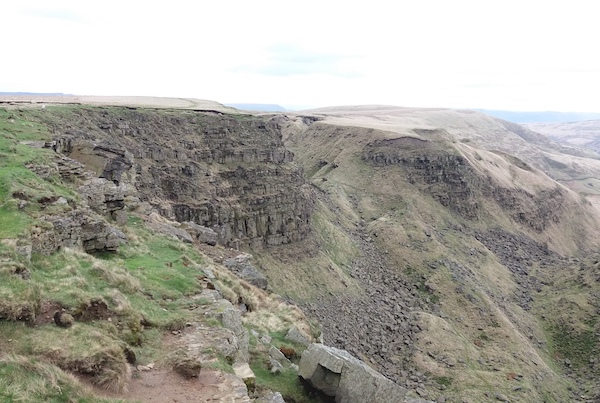I like a bit of wildness! I wonder what image that conjures up in your mind? Coming into my 60th year, perhaps of an aging rocker doing air guitar while head banging to loud music! But while rock music is part of my eclectic musical tastes, that’s not what I mean. I mean wild nature.
As we edge towards the end of another lock down, perhaps like many, you have enjoyed being outside, although with the cold and wet weather of winter that has been more of a challenge than last spring when we had our first lockdown. Many people have appreciated the natural world more over the past year, whether it be your garden, a local park or walking along local footpaths into the countryside wherever you live.
Different things in creation appeal to different people. For some its bird spotting. For others, its wildflowers or trees, or the wild animals that you might catch a glimpse of scampering through the hedgerows and woods, trying to escape your gaze. For me, it’s wild places and wild landscapes.
I’m on sabbatical at the moment. I had hoped to take some time walking a long-distance footpath, but lockdown has restricted me to some local walks out into the Hertfordshire countryside. Very pleasant and refreshing, but you wouldn’t call it wild. Very tame in fact. Lots of farms, stables, and grassy field for grazing, although I am a still wary when I cross a field with cows in. My mind keeps drifting back to my last sabbatical in 2013 when I walked St Oswald’s Way in Northumbria, from Lindisfarne to Heavensfield on Hadrian’s Wall. There was wild coastline, wild moors and even some wild cows!!
Wilderness and wildness are not always comfortable places. I remember walking alone through a particularly dark forest in Northumbria on a very damp day looking for a place to stop for lunch. Having found a sheltered place with a few rocks to sit on, I decided against it. It felt dark and oppressive and I moved on to a more open, lighter if wetter spot to take a break. And another time, walking across the flat, featureless moors of Kinder Scout in the Peak District, becoming edgy as the path petered out and deciding to return to the security of the well-defined path around the edge.
Perhaps at the heart on the unfolding climate and environmental crisis is that we are not comfortable with wilderness and wildness. We like to tame the world, reshaping it to our needs and security. Wild places are disappearing. Back in 2013, I visited BMS worker Laura-Lee Lovering who lives in the small town of Nauta in the Peruvian Amazon where BMS has a mission centre. Looking in the forest one day she commented that local people preferred the ordered cultivated land to the wild jungle. But that ordering and taming has an impact. This week, I read on the BBC that half of UK wildlife has decreased over the past 50 years and their habitats have been squeezed by modern life.
This uncomfortableness with wildness is found in the Bible. Richard Bauckham in “Bible and Ecology” suggests the Bible distinguishes between two different types of land – cultivated and wild places. Places of security and places that are dangerous and full of threat, unfit for human habitation. No wonder we want to tame them. Yet, as we remember during the season of Lent, Jesus spent time in the wilderness;
“he was in the wilderness for forty days, being tempted by Satan. He was with the wild animals.” (Mk 1v13)
Jesus faced threats in the wilderness. From Satan and his temptations, perhaps all about finding security and taming the wildness of God’s purpose for Jesus. Do we face the same temptations today in our drive for security today? Taming the wilderness so it fits our needs and lives. Yet, in doing so, we ignore that this is a part of creation that God makes for the wild animals. Many of the drugs that we use to treat disease such as COVID come from extracts of plants that are found in wild areas like the Amazon. Cutting down the rainforests may seem to bring security now, but what might we lose that will bring us security later in the face of new threats such as COVID. There are even suggestions that COVID skipped from wild animals to humans because we increasingly encroach on wild areas.
In the wilderness, Jesus was “with the wild animals”, but I wonder if he was threatened by them? Or does this express the freedom that God in Jesus wants to bring between the whole community of creation, between human and non-human? Freedom that Isaiah speaks of as he looks for God’s future where;
The wolf will live with the lamb,
the leopard will lie down with the goat,
the calf and the lion and the yearling together;
and a little child will lead them.
They will neither harm nor destroy
on all my holy mountain,
for the earth will be filled with the knowledge of the Lord
as the waters cover the sea. (Isa 11v6-9)
What knowledge might we learn from Jesus being “with the wild animals”? And how can we put it into practice? That will depend upon where you live, or where your church building is placed. Many people put out food for the wild birds in the gardens. Perhaps you could sow some seeds that will attract butterflies. Or make a simple “bee house” for your own or church garden to encourage these insects that play such an important role in sustaining plants that we rely on for food. If your church has land or a graveyard, how might you manage it to provide a home for wild animals. Or you could ask questions about new housing developments locally; how they might provide a home for wild nature as well as people. Maybe there are conservation projects you could support locally or further afield – check out the BMS World Mission Carbon Offsetting tool that supports tree planting projects in Northern Uganda.
This Lent, take time to rewild yourself! Spend time with Jesus in the wilderness, with the wild animals. Take a walk around your garden, in the park or out into the countryside. As you go, you could pray this prayer – it’s also available on the Baptist Union Environment Network (BUEN) YouTube channel – seeking God’s peace for the whole of his community of creation.
A Prayer for Lent – Wilderness and Wildness
Jesus, we are not comfortable with wilderness;
it’s wildness; its otherness beyond human imagining.
We seek order, control, taming it to fit our imagination, needs, our security.
Yet, you were in the wilderness.
Lord of all things in heaven and earth,
In whom, through whom, for whom all things were created;
Tempted by, yet overcoming our fear of the wilderness and
wildness of God.
Jesus, we are not comfortable with the wild animals.
We cage them behind bars or within documentaries;
Push them to the margins by our urban life,
trapped in ever decreasing wild reserves.
Yet, you were with the wild animals.
The Lamb of God, who takes away the sin of the world,
yet not its wildness, lying with the wolf;
Living the harmony of the community of creation
that God brings through you.
Jesus, of the wilderness and
the wild, tame our fears;
May we be made anew,
in you, through you, and for you,
seeking God’s shalom between the
whole community of creation.
Amen
This blog is part of a series from Dave Gregory. To see previous blogs in the series, please click here.

